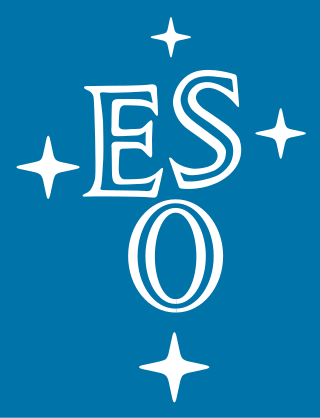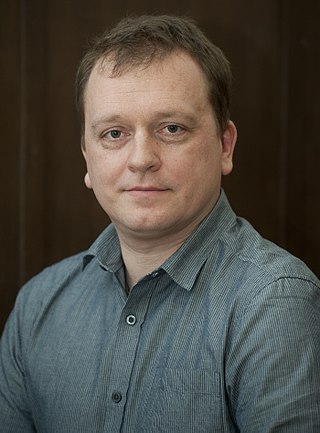Related Research Articles

The International Astronomical Union is a non-governmental organisation with the objective of advancing astronomy in all aspects, including promoting astronomical research, outreach, education, and development through global cooperation. It was founded in 1919 and is based in Paris, France.

The European Organisation for Astronomical Research in the Southern Hemisphere, commonly referred to as the European Southern Observatory (ESO), is an intergovernmental research organisation made up of 16 member states for ground-based astronomy. Created in 1962, ESO has provided astronomers with state-of-the-art research facilities and access to the southern sky. The organisation employs over 750 staff members and receives annual member state contributions of approximately €162 million. Its observatories are located in northern Chile.
Richard Martin West is a Danish astronomer and discoverer of astronomical objects with a long career at the European Southern Observatory (ESO) and at the International Astronomical Union (IAU).

Virginia Louise Trimble is an American astronomer specializing in the structure and evolution of stars and galaxies, and the history of astronomy. She has published more than 600 works in Astrophysics, and dozens of other works in the history of other sciences. She is famous for an annual review of astronomy and astrophysics research that was published in the Publications of the Astronomical Society of the Pacific, and often gives summary reviews at astrophysical conferences. In 2018, she was elected a Patron of the American Astronomical Society, for her many years of intellectual, organizational, and financial contributions to the society.

Teide Observatory, IAU code 954, is an astronomical observatory on Mount Teide at 2,390 metres (7,840 ft), located on Tenerife, Spain. It has been operated by the Instituto de Astrofísica de Canarias since its inauguration in 1964. It became one of the first major international observatories, attracting telescopes from different countries around the world because of the good astronomical seeing conditions. Later, the emphasis for optical telescopes shifted more towards Roque de los Muchachos Observatory on La Palma.

The Royal Observatory, Edinburgh (ROE) is an astronomical institution located on Blackford Hill in Edinburgh. The site is owned by the Science and Technology Facilities Council (STFC). The ROE comprises the UK Astronomy Technology Centre (UK ATC) of STFC, the Institute for Astronomy of the School of Physics and Astronomy of the University of Edinburgh, and the ROE Visitor Centre.

Krisztián Sárneczky is a Hungarian teacher of geography and prolific discoverer of minor planets and supernovae, researching at Konkoly Observatory in Budapest, Hungary. He is a board member of the Hungarian Astronomical Association (HAA) and member of the American Association of Variable Star Observers, leader of the Comet Section of the HAA, and is a contributor in the editorial work of Hungarian Astronomical Almanach.

The International Year of Astronomy (IYA2009) was a year-long celebration of astronomy that took place in 2009 to coincide with the 400th anniversary of the first recorded astronomical observations with a telescope by Galileo Galilei and the publication of Johannes Kepler's Astronomia nova in the 17th century. The Year was declared by the 62nd General Assembly of the United Nations. A global scheme, laid out by the International Astronomical Union (IAU), was also endorsed by UNESCO, the UN body responsible for educational, scientific, and cultural matters.

Nancy Grace Roman was an American astronomer who made important contributions to stellar classification and motions. The first female executive at NASA, Roman served as NASA's first Chief of Astronomy throughout the 1960s and 1970s, establishing her as one of the "visionary founders of the US civilian space program".

Lars Lindberg Christensen is a science communicator and author of a dozen books on astronomy and science communication translated to ten languages.

Catherine Jeanne Cesarsky is an Argentine and French astronomer, known for her research activities in astrophysics and for her leadership in astronomy and atomic energy. She is the current chairperson of the Square Kilometre Array's governing body, SKAO Council. She was the first female president of the International Astronomical Union (2006-2009) and the first female director general of the European Southern Observatory (1999-2007).

Gerard Theodore van Belle is an American astronomer. He is an expert in optical astronomical interferometry.

Isabel Martin Lewis was an American astronomer who was the first woman hired by the United States Naval Observatory as assistant astronomer. In 1918, Lewis was elected a member of the American Astronomical Society. She was also a member of the Royal Astronomical Society of Canada and the Astronomical Society of the Pacific.
Nancy Houk is an American astronomer who led the effort to establish a comprehensive database of stellar temperatures and luminosities.

Maria Teresa Vaz Torrão Lago is a Portuguese astronomer who founded the Centre for Astrophysics of the University of Porto and created the first astronomy degree program in Portugal. Lago is currently the General Secretary of the International Astronomical Union. Her research focuses on the evolution of young stars and she is active in the promotion of astronomy and scientific culture to the public.
Hatice Nüzhet Gökdoğan was a Turkish astronomer, mathematician and academic. After studying mathematics and astronomy in France as a young adult, Gökdoğan joined the faculty of Istanbul University in 1934 and completed her PhD. She was elected Dean of the university's Faculty of Science in 1954, becoming the first Turkish woman to serve as a university dean, and she was later made Chair of the astronomy department, significantly expanding her department's capacity and working to improve national and international collaboration between astronomers.
Dante Minniti is an astronomer born in Santa Fe, Argentina on December 1, 1962. He has devoted his career to the study of stellar populations, stellar evolution, globular clusters, galaxy formation, gravitational microlensing, exoplanets and astrobiology. He has been member of the SuperMACHO Team since 2001 and leader of the VVV Survey along with Phil Lucas since 2006 and of its extended version, the VVVX Survey. He has also fostered new scientists, supervising 14 PhD students, 11 Master Students and 17 Postdocs. He is Full Professor and Director of the Astronomy Institute at Andrés Bello National University (UNAB), Chile.
Karin Lind is a Swedish astronomer whose research involves spectroscopy of stars in order to determine their chemical composition, and the use of this information to understand the origin of heavy elements in supernova explosions and the way radiation and energy moves through stellar atmospheres. Her work has in particular clarified the roles of Big Bang nucleosynthesis and supernovas in producing the quantities of lithium observed in early stars. She is an associate professor in the Department of Astronomy at Stockholm University, and a participant and survey builder in the GALAH collaboration, which uses the Anglo-Australian Telescope's HERMES instrument to map the chemical compositions of stars in the Milky Way.
References
- 1 2 3 ESO’s Francesca Primas recognised for promoting gender equity, European Southern Observatory, 27 September 2023, retrieved 2024-04-11
- 1 2 "Francesca Primas", ORCiD, retrieved 2024-04-11
- ↑ "Francesca Primas", AstroGen, American Astronomical Society, retrieved 2024-04-11
- 1 2 Nancy Grace Roman Award for Promoting Gender Equity, Astronomical Society of the Pacific, 27 September 2023, retrieved 2024-04-11; see also attached pdf announcement